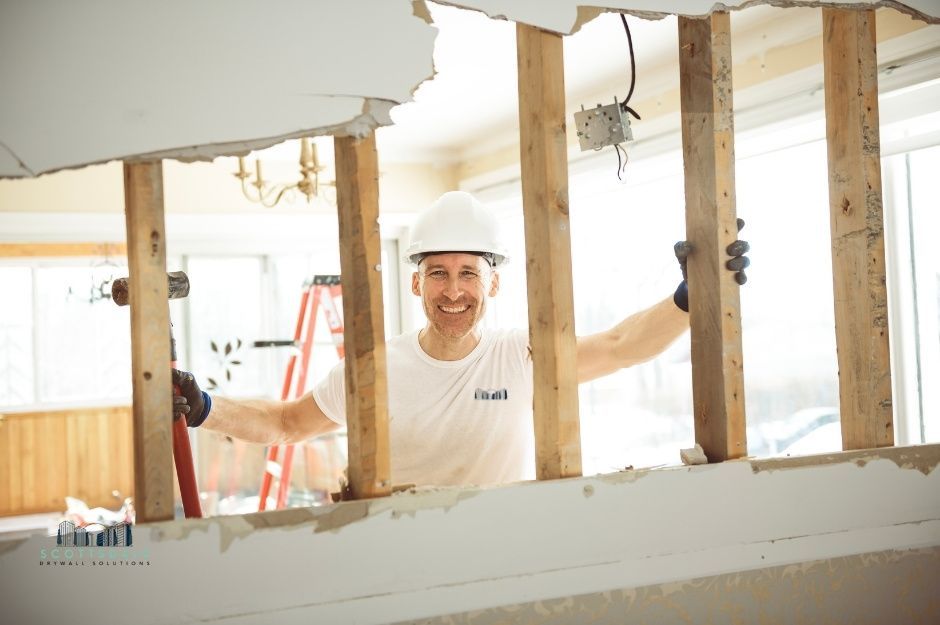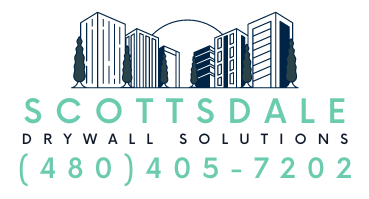Prescott Valley Drywall Repair Services
Trustworthy Sheetrock Repair Contractors in Prescott Valley, Arizona

When your walls show signs of damage, from unsightly cracks to water damage and mold, professional drywall repair services at Scottsdale Drywall Solutions in Prescott Valley can restore your home's appearance and structural integrity. These contractors offer comprehensive solutions including patch repairs, water damage restoration, mold remediation, popcorn ceiling repairs, and expert finishing.
Located at 5,100 feet elevation in central Arizona, Prescott Valley's unique high-desert climate with cold semi-arid conditions (BSk classification) creates specific challenges for drywall maintenance. The town's significant temperature fluctuations - from winter lows of 25°F to summer highs of 89°F - can cause expansion and contraction that leads to stress cracks and joint separation in drywall systems.
Drywall issues can affect any room in your home - bedrooms, kitchens, bathrooms, and garages aren't exempt from damage. Professional repair services help you avoid the common pitfalls of DIY fixes while ensuring proper texture matching and seamless blending with your existing walls.

Scottsdale Drywall Solutions (CP)

Multiple experienced contractors serve the Prescott Valley area's 46,785 residents, offering both residential and commercial drywall services. You'll find specialists who can handle everything from small patch jobs to complete drywall installation and finishing, with teams ready to respond promptly and maintain clean worksites throughout your project.
Expert Drywall Repair Services in Prescott Valley City, Arizona
Professional drywall repair specialists in Prescott Valley City utilize advanced techniques and specialized tools to restore damaged walls and ceilings to their original condition. Local contractors bring extensive expertise in addressing both historic and modern construction requirements, from homes built during the town's 1880s ranching settlement era to contemporary developments that have grown since the town's incorporation in 1978.
Water Damage Restoration
Water-damaged drywall requires immediate professional attention to prevent structural deterioration and mold growth. Specialized moisture meters help identify the full extent of water penetration beyond visible damage.
In Prescott Valley's climate, with an average annual precipitation of 15.02 inches concentrated mainly during monsoon season (July-August receiving 2.39-2.46 inches), water damage often occurs during intense summer storms that can overwhelm roofing and drainage systems.
Your repair specialist will remove all wet materials and thoroughly dry the affected area using industrial dehumidifiers and air movers. This process typically takes 2-4 days.
Professional restoration includes:
- Complete moisture assessment
- Targeted material removal
- Advanced drying techniques
- Wall cavity inspection
- Surface preparation
- Matching existing textures
Mold Remediation Solutions
Mold remediation starts with a comprehensive inspection to identify affected areas and underlying moisture sources. Professional specialists use HEPA filtration systems to contain spores during removal.
Prescott Valley's varying humidity levels throughout the year, with dew points ranging from 20.5°F in December to 51.8°F in August, create conditions where mold can develop in moisture-damaged areas if not properly addressed.
Your remediation process includes proper containment setup and negative air pressure maintenance to prevent cross-contamination. Antimicrobial treatments protect against future growth.
Key remediation steps:
- Professional assessment
- Containment setup
- Safe mold removal
- Surface cleaning
- Preventive treatment
- Air quality testing
Drywall Patching and Hole Repair
Professional patching restores walls damaged by holes, dents, or accidents. Repair specialists match existing textures seamlessly using specialized tools and techniques.
Your repair includes proper surface preparation, reinforcement installation, and expert finishing. Multi-layer compound application ensures smooth transitions.
Standard repair process:
- Area cleaning and preparation
- Support installation
- Patch application
- Texture matching
- Paint blending
Stress Crack and Seam Correction
Stress cracks and failing seams require proper identification of underlying causes for effective repair. Professional specialists assess movement patterns and structural factors.
Prescott Valley's location in Yavapai County, with its geological history including the nearby extinct volcano Glassford Hill (6,177 feet elevation), means homes may experience minor settling that can cause stress cracks. Additionally, the area's significant daily temperature variations contribute to thermal expansion and contraction in building materials.
Your repair team uses flexible compounds and reinforcement materials designed for problem areas. This prevents recurring issues.
Correction techniques include:
- Movement analysis
- Joint tape removal
- Flexible compound application
- Reinforcement installation
- Surface finishing
- Texture matching
Popcorn Ceiling and Specialty Repairs
Professional drywall repair specialists in Prescott Valley excel at fixing complex ceiling and wall issues using specialized techniques and materials. These repairs require precision and expertise to maintain structural integrity while achieving seamless results.
Popcorn Ceiling Repair and Removal
Popcorn ceiling repair services restore the visual appeal of damaged textured surfaces. Professional contractors can fix water stains, cracks, and peeling sections to match your existing texture perfectly.
Many Prescott Valley homes built during the town's major development period from the 1960s-1980s feature popcorn ceilings that are now showing age-related wear. The area's dry climate with low humidity can cause these textured surfaces to become brittle over time.
You can opt for complete popcorn texture removal to modernize your space. The process involves carefully scraping off the old texture, smoothing the surface, and preparing it for a new finish.
Your options after removal include smooth finishing or modern texturing techniques. A smooth ceiling creates a contemporary look, while subtle textures like knockdown or skip trowel offer distinctive alternatives.
Ceiling and Wall Tape Repair
Loose or damaged drywall tape creates unsightly seams and bubbles that weaken wall stability. Professional repair starts with removing compromised tape sections and cleaning the joint thoroughly.
Fresh drywall tape application requires proper embedding in joint compound. Your repair specialist will apply multiple thin layers, allowing proper drying time between coats.
The final steps involve careful sanding and texture matching to blend repairs invisibly with surrounding areas.
Fixing Nail Pops
Nail pops appear as small bumps where fasteners have worked loose from wall studs. Each popped nail needs resetting or replacement with drywall screws for lasting results.
Nail pops are particularly common in Prescott Valley due to the area's temperature extremes and the wood expansion and contraction that occurs with the region's daily temperature swings of 20-30 degrees.
The repair process includes:
- Driving new screws near the popped nails
- Removing old nails
- Patching holes with compound
- Sanding smooth
- Matching surrounding texture
Joint and Seam Reinforcement
Weak or cracked drywall joints need proper reinforcement to prevent future problems. Your specialist will remove damaged material and apply new joint compound with reinforcing tape.
Multiple thin coats create stronger joints than single thick applications. Each layer must dry completely before adding the next coat.
Professional finishing techniques ensure seams disappear completely after texturing and painting.
Professional Drywall Installation Services
Professional drywall installation requires precise measurements, expert handling techniques, and proper material selection. Licensed contractors bring specialized tools and experience to ensure walls and ceilings meet building codes and quality standards.
Prescott Valley's accessibility via Arizona State Routes 89A, 69, and Fain Road makes it convenient for contractors to transport materials and equipment to job sites throughout the community. The town's well-planned infrastructure, developed since incorporation in 1978, provides easy access for service vehicles to reach both residential and commercial properties.
Residential Drywall Installation
Your home's drywall installation needs careful attention to detail for a flawless finish. Professional installers measure and cut panels to fit doorways, windows, and electrical outlets with precision.
Experienced teams handle both new construction and renovation projects in Prescott Valley's diverse housing stock, from historic ranch properties dating to the Fain family's 1880s settlement to modern developments built for the area's growing population of 46,785 residents. They select appropriate panel thickness based on your specific requirements.
Common residential installations include:
- 1/2-inch panels for interior walls
- 5/8-inch fire-rated drywall for garages
- Moisture-resistant panels for bathrooms
- Soundproof drywall for media rooms
Commercial Drywall Projects
Commercial spaces demand durable drywall solutions that meet strict building regulations. Professional installation teams work efficiently to minimize business disruption while maintaining high standards.
Prescott Valley's growing commercial sector, supported by its strategic location 85 miles north of Phoenix with access to Ernest A. Love Field Airport just 8 miles northwest, requires professional drywall solutions for retail, office, and industrial applications.
Contractors use heavy-duty mounting systems and reinforced panels for high-traffic areas. Fire-rated drywall installation provides essential safety features in commercial buildings.
Key commercial installation features:
- Metal stud framing for superior stability
- Fire-resistant barriers between units
- Impact-resistant panels for retail spaces
- Sound isolation systems for offices
Sheetrock and Panel Installation
Panel selection impacts your project's durability and performance. Professional installers evaluate factors like room purpose, moisture exposure, and sound requirements.
Installation techniques include:
- Precise panel alignment
- Proper fastener spacing
- Strategic joint placement
- Level surface creation
Teams use specialized tools to ensure smooth transitions between panels. They apply proper spacing techniques to prevent future cracking and maintain structural integrity.
Your walls receive expert finishing touches with professional-grade materials and tools. Installers check every seam and corner for quality assurance before moving to the finishing phase.
Drywall Finishing and Surface Preparation
Professional drywall finishing requires careful attention to detail and proper techniques to achieve smooth, seamless walls that are ready for paint or other coverings.
In Prescott Valley's high-desert environment, proper finishing is crucial as the low humidity levels (average dew point of 31.1°F annually) can cause joint compound to dry too quickly, potentially leading to cracking or poor adhesion if not applied with proper technique.
Taping and Mudding Techniques
Start by applying self-adhesive mesh tape or paper tape to all seams and corners. For best results, press the tape firmly against joints to prevent air bubbles.
Apply your first coat of joint compound with a 6-inch drywall knife, covering the tape completely. Let this coat dry for 24 hours before proceeding.
Your second coat should extend 2-3 inches beyond the first coat using an 8-inch knife. Feather the edges carefully to minimize sanding later.
Apply a final skim coat using a 12-inch knife, extending 2 inches beyond the second coat. This creates an ultra-smooth transition between the joint and wall surface.
Texture Matching and Blending
Select the appropriate texture tools based on your existing wall pattern - knockdown, orange peel, or smooth finish.
Test your texture mixture and technique on a scrap piece first. Match the texture depth and pattern to surrounding areas for seamless integration.
Use a spray hopper for orange peel texture, or a specialty knockdown knife for that specific finish. Maintain consistent pressure and distance from the wall.
Create smooth transitions between new and existing textures by feathering the edges of your application area.
Final Sanding and Surface Perfection
Begin sanding with 120-grit sandpaper for initial smoothing. Work in circular motions to avoid creating flat spots or grooves.
Prescott Valley's dusty high-desert conditions make proper dust control especially important during sanding operations. Professional contractors use specialized vacuum sanders and containment systems to maintain clean work environments and protect the area's clean air quality.
Use a sanding pole for higher areas and ceilings. Keep your movements steady and apply even pressure across the surface.
Run your hand over sanded areas to feel for imperfections. Mark any rough spots or ridges with a pencil for touch-up work.
Finish with 150-grit sandpaper for ultra-smooth results. Wipe all surfaces with a slightly damp cloth to remove dust before painting.
